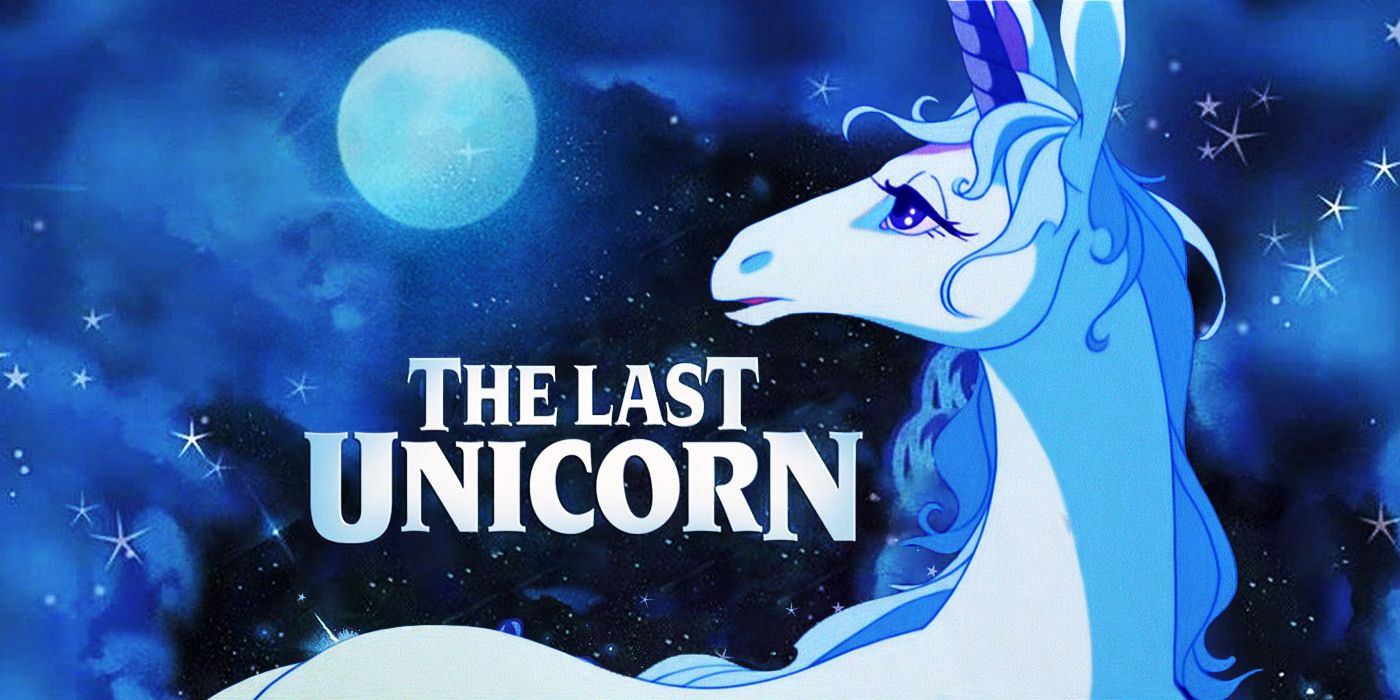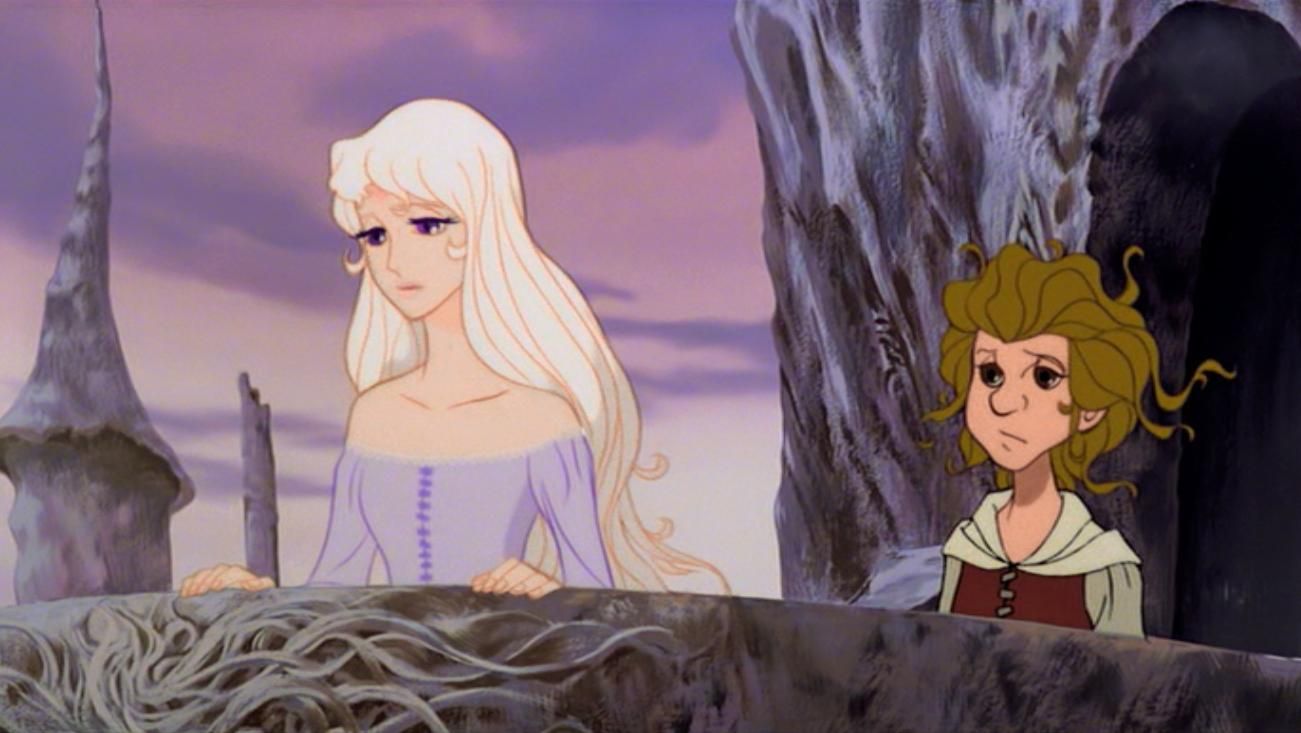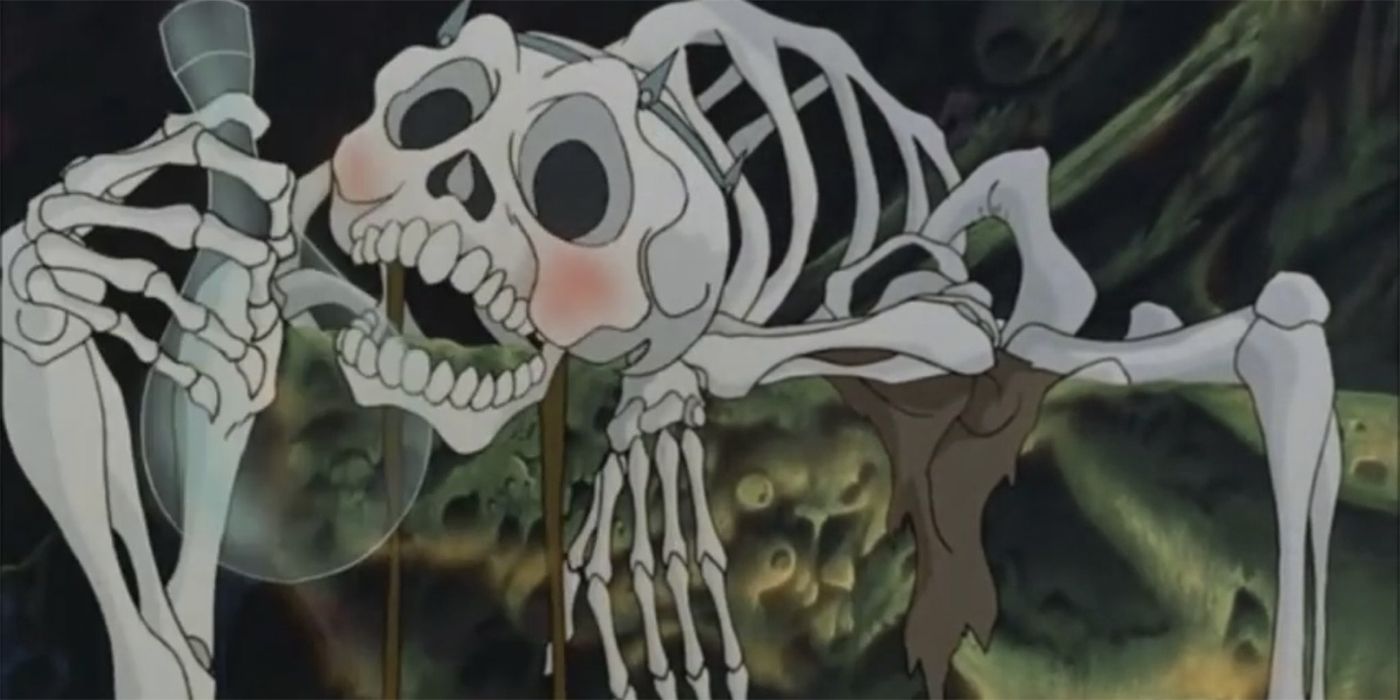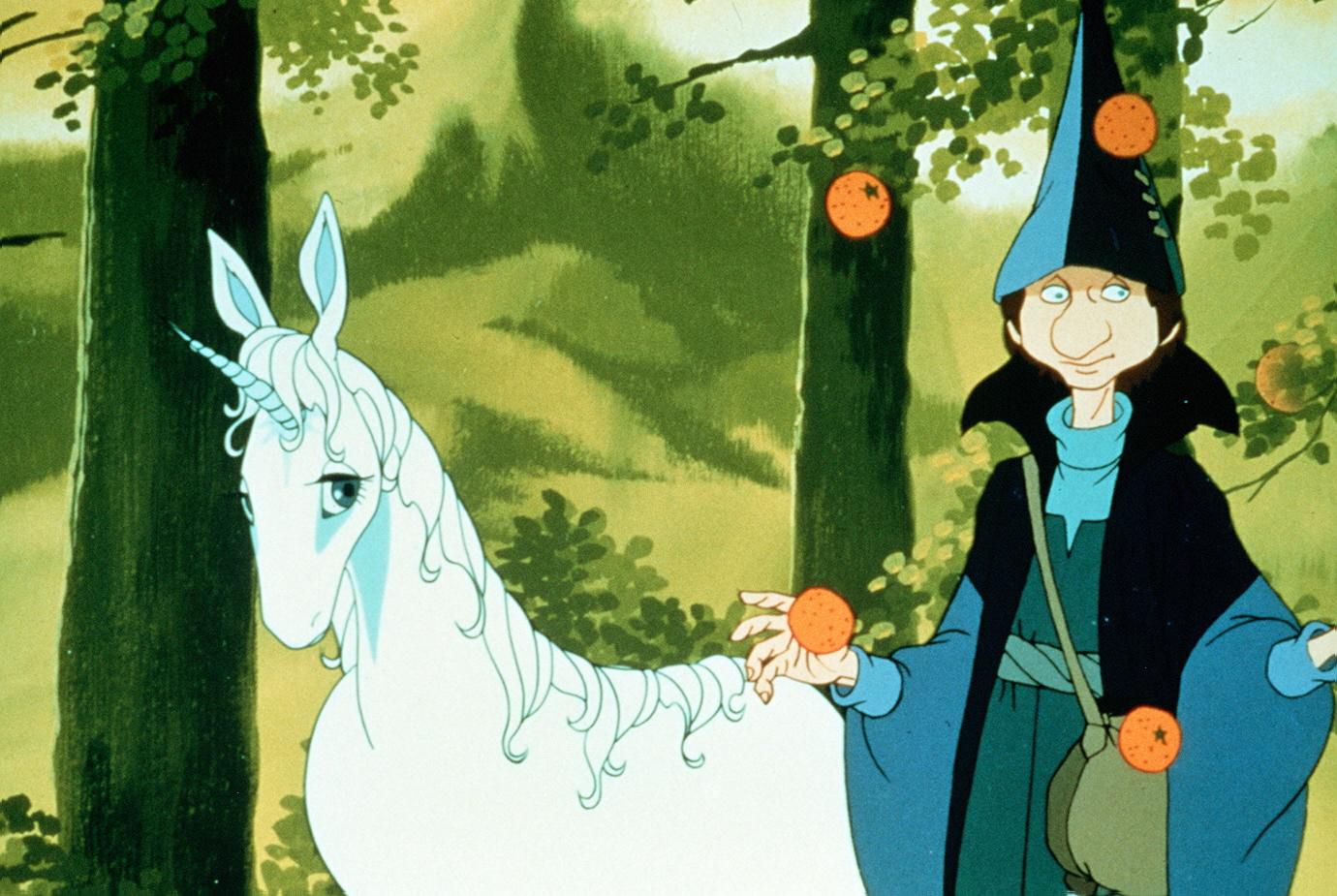40 years ago, in 1982, The Last Unicorn premiered in theaters across the United States. Based on the novel by Peter S Beagle, the film conjured images of dark magic, mortality, and the blurred line between fantasy and reality. While many tote the movie as childhood nightmare fuel, calling to mind gruesome imagery and traumatizing animation, The Last Unicorn has also become a sort of cult-classic, falling into the space where phrases such as ‘when I was a kid, cartoons weren’t afraid to be weird and scary’ are often tossed around. The film falls into the category of ‘dark fantasy,’ popular at the time and often standing in contrast to the more lighthearted and whimsical tales of other fairy tales; in The Last Unicorn, there are no rainbows or sparkles or helpful horned horses to ride into the sunset. The unicorn in the film, voiced by Mia Farrow, takes very little interest in the lives of mortals and her blunt, somewhat apathetic, nature is a sharp contrast to the more popular depictions of unicorns seen today.
The film was produced by Rankin/Bass Productions, which also produced the animated versions of JRR Tolkien’s The Hobbit and Return of the King, as well as classic holiday animations such as the stop-motion films Rudolf the Red-Nosed Reindeer, The Little Drummer Boy, and Santa Claus is Comin' To Town. While Beagle, who also wrote the film’s screenplay, was initially horrified by the idea of using Rankin/Bass to produce the film, noting his dislike of their stop-motion work, the Japanese animation studio hired by Rankin/Bass to animate the film did, in Beagle’s words, ‘lovely design work.’ The animation studio, Top Craft, had worked on previous 2D cell animation for Rankin/Bass. Perhaps best known for one of the last films it ever worked on, Nausicaä of the Valley of the Wind, the studio eventually dissolved in 1985, only a few years after The Last Unicorn was released, and many of its core members would go on to form Studio Ghibli, alongside Hayao Miyazaki. The soundtrack of the film was written by Jimmy Webb and performed by the band America, known for their song A Horse With No Name, and the London Symphony Orchestra.
The film follows the story of the Unicorn, who lives alone in her woods where her magic keeps the animals there protected. In her home it is always Spring, portrayed in colorful hand painted backgrounds and delicate music, and there is little fear of death or sickness. The Unicorn herself is immortal, unable to grow old or die by natural causes, as well as feel emotions such as ‘regret.’ It is here in her woods, where she overhears two hunters call her the last of her kind, remarking on the disappearance of all the other unicorns of the world. Greatly disturbed by this realization and spurred by the poetically jumbled words of a passing butterfly, who’s travels have left him privy to the stories of the world, the Unicorn sets off to find others like her.
Her journey takes her through the world of humankind, where she is forced to reckon with a world that no longer knows her, save for a few who can see her for what she truly is; it is this sense of identity, and the loss of it, that becomes a core theme throughout the entirety of the film. The Unicorn encounters Mommy Fortuna (Angela Lansbury), a witch who captures the Unicorn for her Midnight Circus; magically placing a fake horn on the Unicorn, so that humans can see her for what she truly is, she parades the Unicorn around, alongside a group of other, regular, animals disguised as mythical creatures. Their true identities taken away for the sake of entertainment, the animals become shadows of their former selves, and only the Unicorn and one of Mommy Fortuna’s assistants, Schmendrick the Magician (Alan Arkin), can see them for what they are without the magic.
The film explores this idea of one’s identity, how it defines one’s actions and lifestyle, as well as the process of losing or changing it, in a multitude of ways; more than once, the Unicorn and Schmendrick, who become traveling companions, come across others who bring to mind the concept of identity and truth; a group of bandits lead by Captain Cully (Keenan Wynn), who brags about good deeds and calling himself the ‘real’ Robin Hood, Molly Grue (Tammy Grimes), a woman who resents aging and mourns the loss of her younger self, and even a speaking cat (Paul Frees) who remarks upon his nature as a cat and his inability to stray from it.
Later in the film, identity and its loss are encountered again; the Unicorn is turned into a mortal human woman by untamed magic, and the crisis she experiences is nothing less than haunting. For the first time, she is without her grace, magic, and, perhaps most importantly, her immortality. As she remains in her new human body, trapped by magic meant to save her from the fate of the other unicorns, she begins to lose her sense of self - her life as a unicorn begins to fade, and the human body becomes less and less a veil over her true identity.
It is in the Midnight Circus, however, that source of countless childhood nightmares is met; while the Unicorn’s grapple with a new body is certainly uncomfortable and distressing, it is the Harpy, Celaeno (Keenan Wynn), who takes first place when it comes to this film’s ability to make children cry and parents shudder. Like the Unicorn, the Harpy is immortal and the only other truly magical creature in Mommy Fortuna’s Midnight Circus. When the Unicorn escapes with the help of Schmendrick, she sets the other animals free as well, including Celaeno; it is nearly impossible to erase the sound of Celaeno's gravelly voice as she urges the Unicorn to set her free. Upon her release, the Harpy attacks Mommy Fortuna and her other assistant, killing them; it is a fairly graphic scene for a movie advertised as a ‘family film,’ and the image of Mommy Fortuna’s twisted body is sure to leave a lasting mark on most viewers.
It is here that death and mortality, the other main themes of the movie, are fully introduced; prior to her demise, Mommy Fortuna remarks upon her immortality - that being that she is the only witch in the world to capture and hold a Unicorn, for however long, and that she will thus live on in memory. The concept of immortality and legacy, as mentioned before with Captain Cully, continually pop up over the course of the film. However, unlike in other stories and fairytales, immortality and legacy are never portrayed in positive lights; Mommy Fortuna’s immortality is based around the imprisonment of a magical creature, Captain Cully’s legacy is based in lies, and the Unicorn’s true immortality leaves her unable to comprehend the beauty of mortal life. She is unable to feel things like regret and love, emotions too powerful for her to live with forever.
Characters like Molly Grue, who, as stated before, resents her age, portray more common and accepted views of mortality; Molly Grue yearns for her younger years, demanding to know why the Unicorn, whose kind is known in mythology to appear to young and beautiful maidens, has come to Molly when she is older and no longer ‘new.’ To Molly, the Unicorn’s appearance is a mockery of Molly’s age and impending death. Yet, these negative views do not linger; as the journey continues, it becomes clear that Molly is still full of life, vibrant and adventurous. It is her wisdom and years of experience that help the Unicorn on her journey, leading her and Schmendrick in the correct direction and acting as a voice of reason throughout the rest of the film.
The idea that mortality - that death - is not necessarily a bad thing is not one often seen in most media, let alone children’s films. While death is often talked about or referenced, even sometimes taking a leading role in a film’s story, The Last Unicorn is one of the few films that remarks upon death and mortality as an integral part of the human experience. As said before, with no concept of death as it pertains to her, the Unicorn is unable to feel or comprehend the stronger emotions that others may take for granted. Her transformation into a human is painful and scary - she even laments that she can now feel her body ‘dying all around her’ and that it terrifies her - but it also allows her to experience things she could never have as a unicorn. She encounters love and the joy it brings, as well as regret and the impact it has on her decisions. While her beauty and grace as a unicorn are considered somewhat incomprehensible to mortals, as a human she slowly becomes more ‘real,’ and her beauty becomes something tangible; it is the concept of death, now very real and looming, that breathes life into a creature that was once so far from human that it felt weightless.
Over all, The Last Unicorn comes off as beautifully bittersweet; its art and music create an atmosphere that lends itself to the darker themes that the film and story explore, and the characters defy expectations in their portrayals and purpose. The Unicorn, in particular, stands out amongst her peers in the world of fantasy creatures as something older and more true to the original stories of her kind. While a sort of darkness covers the entire film, growing heavier as the characters move farther and farther away from endless Spring in the Unicorn’s woods, it is the acknowledgement that ‘everything that dies is beautiful’ and that one’s identity is malleable and fluid, that brings a brightness to the story, lightening the shadows and creating a story that is less about facing death and more about celebrating life.





